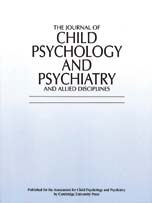Crossref Citations
This article has been cited by the following publications. This list is generated based on data provided by
Crossref.
Volkmar, Fred R.
1999.
Lessons from Secretin.
New England Journal of Medicine,
Vol. 341,
Issue. 24,
p.
1842.
Webster, Alec
Major, Judith
Murray, Olwen
and
Robins, Janet
2000.
Research commissions in the initial professional training of educational psychologists: Examining the case for urban pedagogy.
Educational and Child Psychology,
Vol. 17,
Issue. 4,
p.
4.
Mackowiak, Monika
2000.
Aetiology of Autism — Focus on the Biological Perspective.
Early Child Development and Care,
Vol. 160,
Issue. 1,
p.
77.
Arthur, Michele R.
Rotatori, Anthony F.
and
Wahlberg, Tim
2001.
Autistic Spectrum Disorders: Educational and Clinical Interventions.
Vol. 14,
Issue. ,
p.
235.
Tømming, Maiken A.
2001.
Autisme og den udvidede fænotype.
Nordisk Psykologi,
Vol. 53,
Issue. 4,
p.
325.
Greig, Anne
2001.
The educational psychologist as practitioner-researcher: Reality or dream?.
Educational and Child Psychology,
Vol. 18,
Issue. 4,
p.
75.
Korvatska, Elena
Van de Water, Judy
Anders, Thomas F.
and
Gershwin, M.Eric
2002.
Genetic and Immunologic Considerations in Autism.
Neurobiology of Disease,
Vol. 9,
Issue. 2,
p.
107.
Webster, Alec
Webster, Valerie
and
Feiler, Anthony
2002.
Research evidence, polemic and evangelism: How decisions are made on early intervention in autistic spectrum disorder.
Educational and Child Psychology,
Vol. 19,
Issue. 3,
p.
54.
Rinehart, Nicole J.
Bradshaw, John L.
Brereton, Avril V.
and
Tonge, Bruce J.
2002.
A Clinical and Neurobehavioural Review of High-Functioning Autism and Asperger's Disorder.
Australian & New Zealand Journal of Psychiatry,
Vol. 36,
Issue. 6,
p.
762.
Howlin, Patricia
2002.
Selected Proceedings of the Second International Conference on Child & Adolescent Mental Health.
Vol. 2,
Issue. ,
p.
69.
Acosta, Maria T.
and
Pearl, Phillip L.
2003.
The neurobiology of autism: New pieces of the puzzle.
Current Neurology and Neuroscience Reports,
Vol. 3,
Issue. 2,
p.
149.
Klin, Ami
2003.
Asperger syndrome: an update.
Revista Brasileira de Psiquiatria,
Vol. 25,
Issue. 2,
p.
103.
Sutherland, Dean E.
Gillon, Gail G.
and
Yoder, David E.
2005.
AAC use and service provision: A survey of New Zealand speech-language therapists.
Augmentative and Alternative Communication,
Vol. 21,
Issue. 4,
p.
295.
Rutter, Michael
2005.
Autism Research: Lessons from the Past and Prospects for the Future.
Journal of Autism and Developmental Disorders,
Vol. 35,
Issue. 2,
p.
241.
Stobie, Ingeborg
Boyle, James
and
Woolfson, Lisa
2005.
Solution-Focused Approaches in the Practice of UK Educational Psychologists.
School Psychology International,
Vol. 26,
Issue. 1,
p.
5.
Holzer, Laurent
Mihailescu, Raluca
Rodrigues-Degaeff, Catherine
Junier, Laurent
Muller-Nix, Carole
Halfon, Oliver
and
Ansermet, François
2006.
Community Introduction of Practice Parameters for Autistic Spectrum Disorders: Advancing Early Recognition.
Journal of Autism and Developmental Disorders,
Vol. 36,
Issue. 2,
p.
249.
Goldberg Edelson, Meredyth
2006.
Are the Majority of Children With Autism Mentally Retarded?.
Focus on Autism and Other Developmental Disabilities,
Vol. 21,
Issue. 2,
p.
66.
RUTTER, MICHAEL
2006.
Autism.
Journal of Developmental & Behavioral Pediatrics,
Vol. 27,
Issue. Supplement 2,
p.
S54.
Bogte, Hans
Flamma, Bert
van der Meere, Jaap
and
van Engeland, Herman
2007.
Post-error adaptation in adults with high functioning autism.
Neuropsychologia,
Vol. 45,
Issue. 8,
p.
1707.
Bogte, Hans
Flamma, Bert
van der Meere, Jaap
and
van Engeland, Herman
2008.
Cognitive flexibility in adults with high functioning autism.
Journal of Clinical and Experimental Neuropsychology,
Vol. 30,
Issue. 1,
p.
33.


